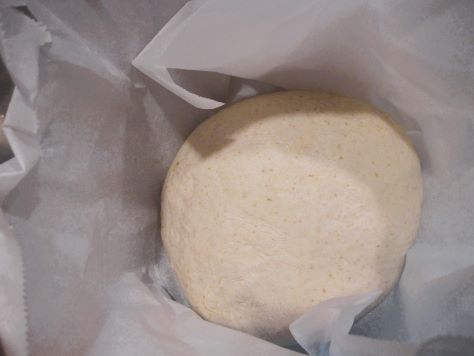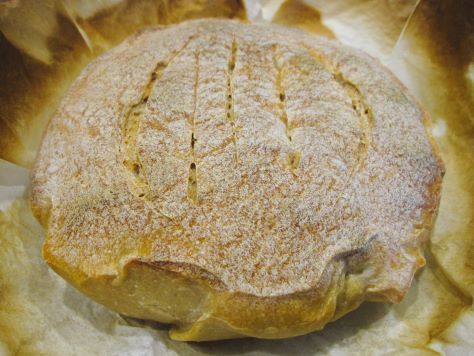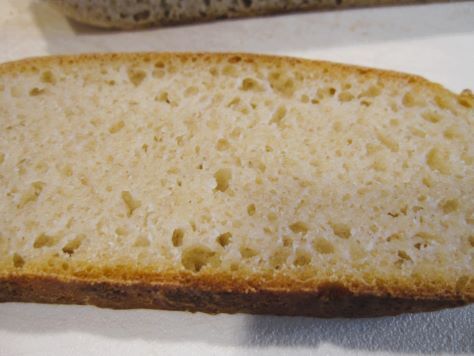Bready or Not: Small Sourdough Boule
Begin the year as you intend to go, that’s what I have often heard. Therefore, we’re kicking off 2025 with a small bread round that entirely relies on sourdough starter as the rising agent. This Small Sourdough Boule begins a series of sourdough recipes that will continue into the fall, building up to the release of my new fantasy book from 47North, A House Between Sea and Sky.

One of my characters is a sentient sourdough starter by the name of Mother. Yes, I said “character.” Mother does not speak, but her feelings are still made known. I had early readers say that it was a testament to my writing that they came to deeply care for a sourdough starter.

Sourdough has a life cycle. It requires consistent maintenance to stay active. For this recipe, use a mature starter (at least a few days old) and feed it a half day before commending this recipe. Meaning, if the last feeding was in the evening, start making the dough the next morning. Because this bread relies entirely on the starter for leavening, the dough needs to be begun about a day and a half in advance of baking.
 PrintBready or Not: Small Sourdough BouleUse a mature sourdough starter that was last fed about 12 hours before. This dough, with start as the sole leaven, requires about a day and a half of slow rise prior to baking. Therefore, the recipe assumes that the dough is started in the morning and then baked at some point the next day. Adjust as needed to your own sleep/work cycle.Course BreadCuisine FrenchKeyword yeast breadPrep Time 20 hours hoursAuthor Beth CatoEquipmentnonstick spray or oilparchment paperplastic wrap or towelsmall cast iron skillet or baking pan.Ingredients3 2/3 cups bread flour or all-purpose flour1 3/4 teaspoons salt1 1/2 cups water room temperature1/3 cup mature sourdough starter (83 grams)InstructionsMix flour and salt in a large mixing bowl. In another bowl, whisk together the starter and water. Pour wet ingredients into the dry, mixing until the dough looks smooth and is no longer tacky. In a stand mixer with bread hook, this will be about 10 minutes.Turn the dough onto the counter and form it into a ball by tucking dough underneath the tighten the top. Apply nonstick spray or oil to the bowl. Place dough back inside and turn it to coat the surface with oil.Line another large bowl with parchment paper. Place dough inside, seam side down. Cover with a towel or plastic wrap and allow dough to rise for about 12 hours at room temperature.Transfer bowl to fridge to continue its fermenting overnight. Keep there until baking time at some point the next day.Preheat oven at 500 degrees. Place the small cast iron skillet or baking pan inside to heat up as well. Once the oven and pan are at full heat, CAREFULLY remove pan from inside.Pull dough from fridge. Set aside the towel or plastic wrap. Use the parchment as a sling to transfer dough to the hot pan. Use a knife or French lame to score the top so that carbon dioxide can escape the bread as it bakes.Place pan in oven. After closing the door, change the heat to 475 degrees.Bake for 20 minutes. Lower the temperature to 350 and bake for another 20 minutes.When done, the loaf should sound hollow when thumped. A digital thermometer plunged into the center should read over 190 degrees.Let cool for at least 20 minutes before slicing in. Enjoy hot or at room temperature. Fresh bread can also be frozen for later enjoyment.OM NOM NOM!
PrintBready or Not: Small Sourdough BouleUse a mature sourdough starter that was last fed about 12 hours before. This dough, with start as the sole leaven, requires about a day and a half of slow rise prior to baking. Therefore, the recipe assumes that the dough is started in the morning and then baked at some point the next day. Adjust as needed to your own sleep/work cycle.Course BreadCuisine FrenchKeyword yeast breadPrep Time 20 hours hoursAuthor Beth CatoEquipmentnonstick spray or oilparchment paperplastic wrap or towelsmall cast iron skillet or baking pan.Ingredients3 2/3 cups bread flour or all-purpose flour1 3/4 teaspoons salt1 1/2 cups water room temperature1/3 cup mature sourdough starter (83 grams)InstructionsMix flour and salt in a large mixing bowl. In another bowl, whisk together the starter and water. Pour wet ingredients into the dry, mixing until the dough looks smooth and is no longer tacky. In a stand mixer with bread hook, this will be about 10 minutes.Turn the dough onto the counter and form it into a ball by tucking dough underneath the tighten the top. Apply nonstick spray or oil to the bowl. Place dough back inside and turn it to coat the surface with oil.Line another large bowl with parchment paper. Place dough inside, seam side down. Cover with a towel or plastic wrap and allow dough to rise for about 12 hours at room temperature.Transfer bowl to fridge to continue its fermenting overnight. Keep there until baking time at some point the next day.Preheat oven at 500 degrees. Place the small cast iron skillet or baking pan inside to heat up as well. Once the oven and pan are at full heat, CAREFULLY remove pan from inside.Pull dough from fridge. Set aside the towel or plastic wrap. Use the parchment as a sling to transfer dough to the hot pan. Use a knife or French lame to score the top so that carbon dioxide can escape the bread as it bakes.Place pan in oven. After closing the door, change the heat to 475 degrees.Bake for 20 minutes. Lower the temperature to 350 and bake for another 20 minutes.When done, the loaf should sound hollow when thumped. A digital thermometer plunged into the center should read over 190 degrees.Let cool for at least 20 minutes before slicing in. Enjoy hot or at room temperature. Fresh bread can also be frozen for later enjoyment.OM NOM NOM!



